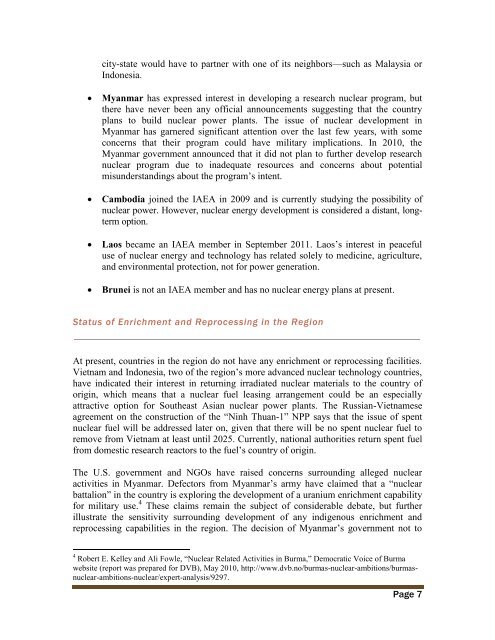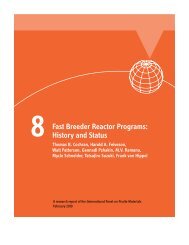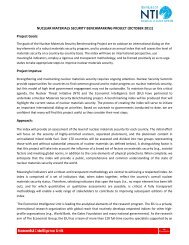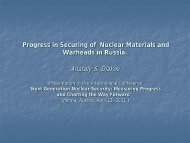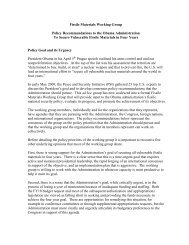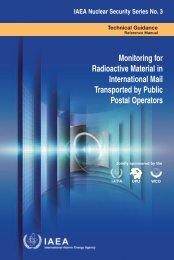Prospects for Nuclear Security Partnership in Southeast Asia - CNS
Prospects for Nuclear Security Partnership in Southeast Asia - CNS
Prospects for Nuclear Security Partnership in Southeast Asia - CNS
You also want an ePaper? Increase the reach of your titles
YUMPU automatically turns print PDFs into web optimized ePapers that Google loves.
city-state would have to partner with one of its neighbors—such as Malaysia orIndonesia.Myanmar has expressed <strong>in</strong>terest <strong>in</strong> develop<strong>in</strong>g a research nuclear program, butthere have never been any official announcements suggest<strong>in</strong>g that the countryplans to build nuclear power plants. The issue of nuclear development <strong>in</strong>Myanmar has garnered significant attention over the last few years, with someconcerns that their program could have military implications. In 2010, theMyanmar government announced that it did not plan to further develop researchnuclear program due to <strong>in</strong>adequate resources and concerns about potentialmisunderstand<strong>in</strong>gs about the program’s <strong>in</strong>tent.Cambodia jo<strong>in</strong>ed the IAEA <strong>in</strong> 2009 and is currently study<strong>in</strong>g the possibility ofnuclear power. However, nuclear energy development is considered a distant, longtermoption.Laos became an IAEA member <strong>in</strong> September 2011. Laos’s <strong>in</strong>terest <strong>in</strong> peacefuluse of nuclear energy and technology has related solely to medic<strong>in</strong>e, agriculture,and environmental protection, not <strong>for</strong> power generation.Brunei is not an IAEA member and has no nuclear energy plans at present.Status of Enrichment and Reprocess<strong>in</strong>g <strong>in</strong> the RegionAt present, countries <strong>in</strong> the region do not have any enrichment or reprocess<strong>in</strong>g facilities.Vietnam and Indonesia, two of the region’s more advanced nuclear technology countries,have <strong>in</strong>dicated their <strong>in</strong>terest <strong>in</strong> return<strong>in</strong>g irradiated nuclear materials to the country o<strong>for</strong>ig<strong>in</strong>, which means that a nuclear fuel leas<strong>in</strong>g arrangement could be an especiallyattractive option <strong>for</strong> <strong>Southeast</strong> <strong>Asia</strong>n nuclear power plants. The Russian-Vietnameseagreement on the construction of the “N<strong>in</strong>h Thuan-1” NPP says that the issue of spentnuclear fuel will be addressed later on, given that there will be no spent nuclear fuel toremove from Vietnam at least until 2025. Currently, national authorities return spent fuelfrom domestic research reactors to the fuel’s country of orig<strong>in</strong>.The U.S. government and NGOs have raised concerns surround<strong>in</strong>g alleged nuclearactivities <strong>in</strong> Myanmar. Defectors from Myanmar’s army have claimed that a “nuclearbattalion” <strong>in</strong> the country is explor<strong>in</strong>g the development of a uranium enrichment capability<strong>for</strong> military use. 4 These claims rema<strong>in</strong> the subject of considerable debate, but furtherillustrate the sensitivity surround<strong>in</strong>g development of any <strong>in</strong>digenous enrichment andreprocess<strong>in</strong>g capabilities <strong>in</strong> the region. The decision of Myanmar’s government not to4 Robert E. Kelley and Ali Fowle, “<strong>Nuclear</strong> Related Activities <strong>in</strong> Burma,” Democratic Voice of Burmawebsite (report was prepared <strong>for</strong> DVB), May 2010, http://www.dvb.no/burmas-nuclear-ambitions/burmasnuclear-ambitions-nuclear/expert-analysis/9297.Page 7


